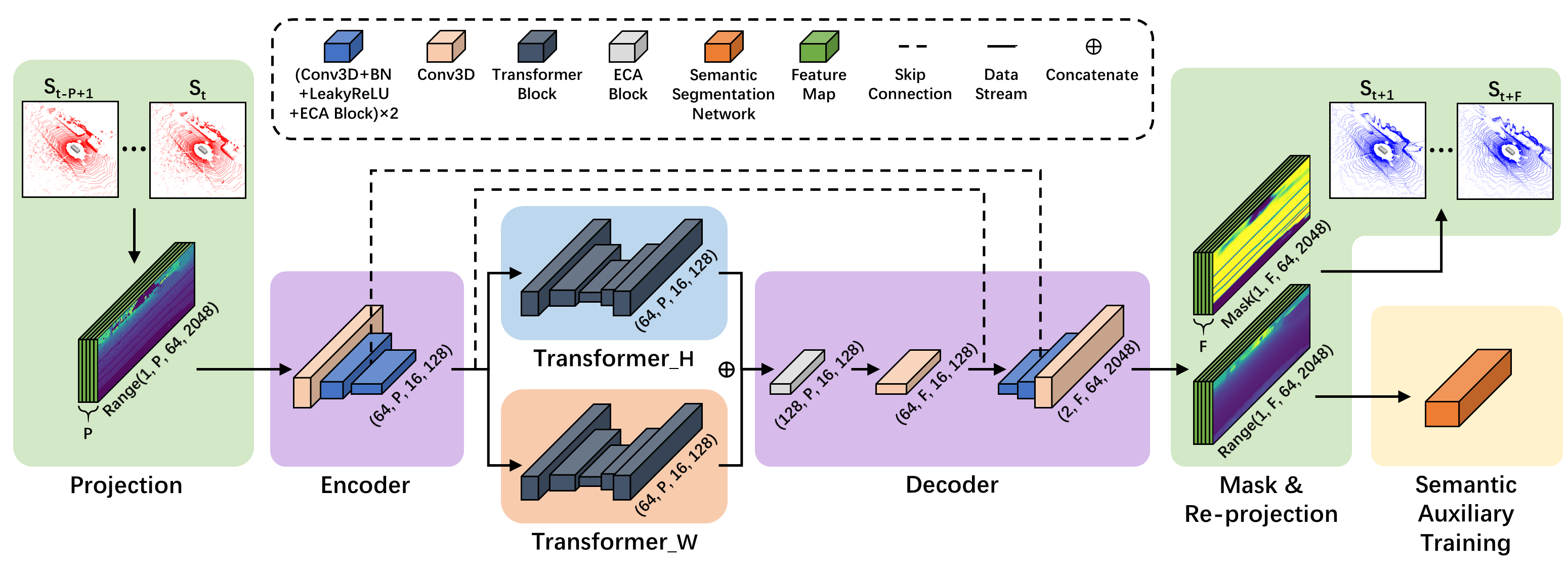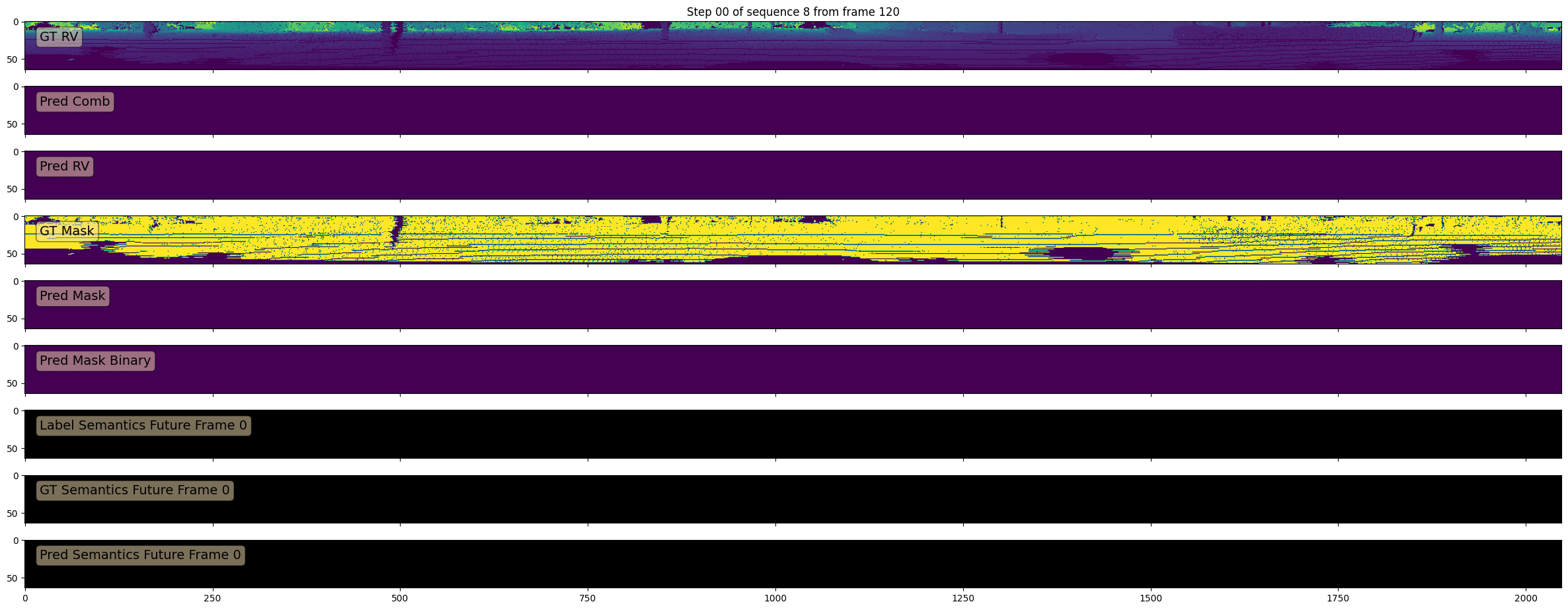Accepted by IEEE RA-L.
Developed by Zhen Luo and Junyi Ma.
PCPNet predicts future range images based on past range image sequences. The semantic information of sequential range images is extracted for auxiliary training, making the outputs of PCPNet closer to the ground truth in semantics.
Ground truth and future range images predicted by PCPNet.
- Publication
- Dataset
- Installation
- Training
- Semantic-Auxiliary-Training
- Testing
- Visualization
- Download
- Acknowledgment
- License
 Overall architecture of our proposed PCPNet. The input range images are first downsampled and compressed along the height and width dimensions respectively to generate the sentence-like features for the following Transformer blocks. The enhanced features are then combined and upsampled to the predicted range images and mask images. Semantic auxiliary training is used to improve the practical value of predicted point clouds.
Overall architecture of our proposed PCPNet. The input range images are first downsampled and compressed along the height and width dimensions respectively to generate the sentence-like features for the following Transformer blocks. The enhanced features are then combined and upsampled to the predicted range images and mask images. Semantic auxiliary training is used to improve the practical value of predicted point clouds.
If you use our code in your academic work, please cite the corresponding paper:
@ARTICLE{10141631,
author={Luo, Zhen and Ma, Junyi and Zhou, Zijie and Xiong, Guangming},
journal={IEEE Robotics and Automation Letters},
title={PCPNet: An Efficient and Semantic-Enhanced Transformer Network for Point Cloud Prediction},
year={2023},
volume={8},
number={7},
pages={4267-4274},
doi={10.1109/LRA.2023.3281937}}We use the KITTI Odometry dataset to train and evaluate PCPNet in this repo, which you can download here.
Besides, we use SemanticKITTI for semantic auxiliary training, which you can download here.
Clone this repository and run
cd PCPNet
git submodule update --initto install the Chamfer distance submodule. The Chamfer distance submodule is originally taken from here with some modifications to use it as a submodule.
All parameters are stored in config/parameters.yaml.
In this project, we use CUDA 11.4, pytorch 1.8.0 and pytorch-lightning 1.5.0. All other dependencies are managed with Python Poetry and can be found in the poetry.lock file. If you want to use Python Poetry, install it with:
curl -sSL https://raw.githubusercontent.com/python-poetry/poetry/master/install-poetry.py | python -Install Python dependencies with Python Poetry
poetry installand activate the virtual environment in the shell with
poetry shellWe process the data in advance to speed up training. The preprocessing is automatically done if GENERATE_FILES is set to True in config/parameters.yaml.
If you have not pre-processed the data yet, please set GENERATE_FILES: True in config/parameters.yaml, and run the training script by
python train.py --rawdata /PATH/TO/RAW/KITTI/dataset/sequences --dataset /PATH/TO/PROCESSED/dataset/in which --rawdata points to the directory containing the train/val/test sequences specified in the config file and --dataset points to the directory containing the processed train/val/test sequences
If you have already pre-processed the data, please set GENERATE_FILES: False to skip this step, and run the training script by
python train.py --dataset /PATH/TO/PROCESSED/dataset/To resume from a checkpoint, please run the training script by
python train.py --dataset /PATH/TO/PROCESSED/dataset/ --resume /PATH/TO/YOUR/MODEL/You can also use the flag--weights to initialize the weights from a pre-trained model. Pass the flag --help if you want to see more options.
A directory will be created in runs which saves everything like the model files, used config, logs, and checkpoint.
If you want to use our proposed semantic auxiliary training strategy, you need to first pre-train a semantic segmentation model. We provide codes for semantic auxiliary training using RangeNet++ in semantic_net/rangenet. To use these codes, please first clone the official codes of RangeNet++ and train a semantic segmentation model.
Note that we recommend using squeezesegV2 backbone without CRF and only use range in the input_depth option while training RangeNet++, according to the codes we are currently providing. If you want to use other backbones, please make corresponding modifications to class loss_semantic in pcpnet/models/loss.py.
Once you have completed the pre-training, you need to copy the folder containing the pre-trained model to semantic_net/rangenet/model/ and modify SEMANTIC_PRETRAINED_MODEL in config/parameters.yaml to the folder name.
After completing the above steps, you can start to use semantic auxiliary training by running the training script by
python train.py --dataset /PATH/TO/PROCESSED/dataset/Note that you need to set LOSS_WEIGHT_SEMANTIC in config/parameters.yaml to the weight you want (we recommend 1.0) instead of 0.0 before running the training script.
You can evaluate the performance of the model by running
python test.py --dataset /PATH/TO/PROCESSED/dataset/ --model /PATH/TO/YOUR/MODEL/Note: Please use the flag -s if you want to save the predicted point clouds for visualization, and -l if you want to test the model on a smaller amount of data. By using the flag -o, you can only save the predicted point clouds without computing loss to accelerate the speed of saving.
After passing the -s flag or the -oflag to the testing script, the predicted range images will be saved as .png files in runs/MODEL_NAME/test_TIME/range_view_predictions. The predicted point clouds are saved to runs/MODEL_NAME/test_TIME/point_clouds. You can visualize the predicted point clouds by running
python visualize.py --path runs/MODEL_NAME/test_TIME/point_cloudsPlease download the car model from here and put it into ./car_ model/ to display the car during the visualization process.
You can download our pre-trained model from this link. Just extract the zip file into runs.
We would like to thank Benedikt Mersch, Andres Milioto and Christian Diller et al. for their significant contributions in the field of point cloud processing. Some of the code in this repo is borrowed from TCNet, RangeNet++, and pyTorchChamferDistance. Thank all the authors for their awesome projects.
This project is free software made available under the MIT License. For details see the LICENSE file.

